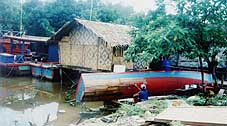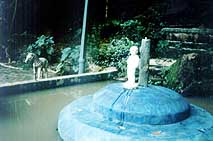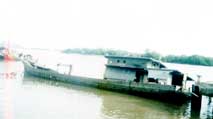by Duncan Stearn
In the wake of the September 11 terrorist attacks in the
United States and the subsequent Western response against Afghanistan, many
governments have issued warnings to their citizens about travelling to certain
countries. Thailand, specifically the southern provinces adjacent to Muslim
Malaysia, is among those included as being potentially dangerous for Caucasian
travellers.
Around 80% of the population in these provinces are
followers of Islam and, prima facie, may be supportive of people such as Osama
bin Laden and potentially unwelcoming to Westerners.
 Not
quite ready for the America’s Cup
Not
quite ready for the America’s Cup
As it was time to renew my visa I decided to travel down
into south Thailand to see first-hand whether there was any reason to avoid
this particular region of the country.
The plan was to catch the overnight train to Hat Yai, cross
the border at Pedang Besar, return to Hat Yai and take a bus for the
100-kilometre journey to the small town of Satun, a staging point for the
Malaysian island of Langkawi and Tarutao, the former pirate island basking in
the warm current of the Andaman Sea.
The midday bus from Pattaya to Ekkamai decided to go via
Chonburi, just to drop off one passenger (probably a relative of the bus
driver). So, it was 2:15 p.m. when it pulled up at Ekkamai; my train was due
to depart Hualumphong Station at 2:45 p.m.
I caught the Skytrain to the National Stadium stop, the
closest to Hualumphong. That’s ‘closest’ in the sense of still being in
the same city, not ‘closest’ in the sense of being ‘not far away’.
 Satun’s
version of the Mannekin Pis
Satun’s
version of the Mannekin Pis
It was now about 2:30 p.m. and for reasons best known to my
inner psyche, I decided to bypass the assembled multitude of motorbike taxis
and tuk-tuks arrayed in front of National Stadium and walked to the main road.
This perambulatory exercise ate up around six minutes of my
precious time. Needing vehicular transportation I hired a motorbike taxi,
agreeing to his 30 baht impost. Unfortunately, he seemed to think he should
give me value for my money and embarked on the tourist route to Hualumphong.
This operation in scenic motorcycling involved an extended look at traffic
scooting hither and yon while we sat at a series of red lights, waiting for
them to turn some shade of green. This was Murphy’s Law in action and was
especially annoying at the set leading to Hualumphong. I was literally a
stone’s throw from the great Gothic portico of the station, with my watch
showing 2:43 p.m. Anyone familiar with the Bangkok traffic light system would
know there isn’t one, a system that is. So you can be stuck at a red light
until either (a) hell freezes over or (b) your train departs, whichever comes
first.
At 2.44 p.m. the lights experienced a malfunction, changed
to green and a few seconds later I found myself dodging an on-coming bus
before ducking under a chain strung across the pedestrian walkway and entering
the station. The luminous clock above the departure board shone 14:45 (2:45
p.m.) like an accusing beacon. I rushed across the marbled surface to the
platform gates and asked an attendant where the Number 37 train could be
found.
In all my previous trips by rail I had never been on a
train that departed on time. Needless to say, on this occasion the Railway
Authority of Thailand was determined to emulate Benito Mussolini and my
locomotive was just beginning to move away from Platform Five. The railway
attendant, to his credit, was galvanised into action and shouted at the guard
in the rear carriage. I ran, in as dignified a manner as one does when late
for a train, while the guard waved a red flag like an accomplished toreador on
amphetamines. Thankfully, the train slowed sufficiently for me to clamber
aboard.
My carriage (a second-class air-conditioned sleeper; upper
berth for 675 baht to Hat Yai) proved to be the worst I’ve ever sat or tried
to sleep in. It was like being inside a blender as the bogie rattled and
bounced around, exhibiting all the symptoms of the train equivalent of
advanced Parkinson’s disease.
We rattled into Hat Yai in the early morning and I paid 25
baht for a bus to Pedang Besar. The border crossing and return was easy and
uneventful with the Malaysian Customs and Immigration people being helpful,
exhibiting no sign of animosity towards foreigners.
Hat Yai to Satun
Buses between Hat Yai and places such as Pedang Besar,
Phattalung, Songkhla and Satun run regularly and I caught an air-conditioned
coach for the run to Satun. The fare was 45 baht.
The topography between Hat Yai and Satun ranges from
flatland to heavily-forested ridges, caressed by tufts of mist that resembled
Indian smoke signals rather than the apparitions of Mother Nature.
Satun is not a particularly large city and I found
accommodation on the road to the port area at the Amm Guesthouse (676 M3
Sulakanukroon Road, Ko-Nok; telephone 01 738 4521). The place is fairly
rudimentary, but clean, new and personal, as you’d expect from a place with
just four rooms for rent. The tariff is 300 baht a night (including American
breakfast) for a room with a double mattress and a mosquito net, a wall fan
and cold water shower. At night the ambient noises are those of skittering
lizards and the odd ‘plop’ as a marine creature breeches in the creek
behind the guesthouse.
Amm, the guesthouse operator told me, “I was married to
an Austrian and lived in Vienna for 14 years. I can speak German very well,
but my English is not so good.” From my point of view the former hairdresser
spoke good English.
Around Satun
The port area is the place that most foreign visitors to
Satun first see, the majority coming from, rather than heading too, Malaysia
and the one ferry I saw disgorged a horde of Malay and Thai passengers and
only one Westerner.
Left of the berth for the Langkawi-Satun Ferry lies the Anjas
Moro. Listing heavily to starboard it serves as a salient reminder that
these waters are home to smugglers and the odd Thai version of Long John
Silver. A senior customs officer told me the Anjas Moro was a
wooden-hulled Indonesian fishing boat caught a number of years ago smuggling a
large quantity of heroin.
 The
Smugglers at rest
The
Smugglers at rest
A naval patrol boat was tied to a jetty while further down,
at another pier, were three customs vessels: two speedboats and a launch. My
customs officer told me he sometimes spent up to three weeks off the coast
engaged in surveillance operations.
On the flanks of Satun City I visited a Buddhist temple
complex. At its entrance was a white-walled two-storey house surrounded by
Ionian-like pillars, an architectural aberration. It was something you’d
expect to find in Tuscany or the Italianised suburbs of a city like Sydney.
The main attraction in the temple is the 236-step walk up
the steel walkway to the top of the massive hill that rises like a Phoenix out
of the ground providing a panoramic view of Satun and the surrounding
countryside. At one point the walk becomes more like a climb as some 100-odd
steps rise at around an 80-degree angle. Reaching the top I knew I was in no
shape for a crack at Buddha Hill in Pattaya, let alone contemplating an
assault on Mount Everest.
Next to the river cutting through Satun is a popular picnic
spot with locals who bring food for the dozens of gibbons that live in the
trees and caves of the surrounding eminence.
The other noteworthy feature in this park is the Satun
version of the Mannekin Pis, that icon of urology created by Jerome Duquesnoy
in 1619, now the defining tourist attraction of Brussels.
In the main town the blue and white minaret of a mosque and
the red and gold painted entrance to a temple could be seen within a call to
Mecca of each other. Women wrapped in veils and headscarves and men in long
robes mingled in the shops alongside boys and girls in jeans. The open-sided
restaurant at Satun port offered halal food alongside the usual Thai fare.
Everywhere I walked I was met with the famous Thai smile
and greeted with cries of “hello”, usually from groups of three teenagers
riding a motorbike and “hey, you” from clusters of men gathered around
plastic tables groaning under the weight of whisky, soda and coke bottles. One
of the broadest smiles I received came from a girl in a headscarf serving
halal food at the open restaurant at the port.
The only other foreigners I saw during my brief stay in
Satun were wandering through the second-hand market, a feature of Saturday
evenings in the somnolent town. The number of video rental stores is perhaps
indicative of a lack of broader entertainment. Many shops not only had Thai
and Chinese script, but also Bahasa Malay.
The first and only time a stranger uttered the mantra
‘bin Laden, bin Laden’ was when it came time for me to board the mini-bus
for the 60 baht trip back to Hat Yai. Even then, the person speaking had a
broad grin on his face, and there was no hint of malice or aggression in his
voice.
I enjoyed my time in Satun and Hat Yai and was again left
to wonder about how easy it is for the media to instil a fear of travelling
into ordinary people, simply because it is easier for us to collectively
accept what we read and hear without question.